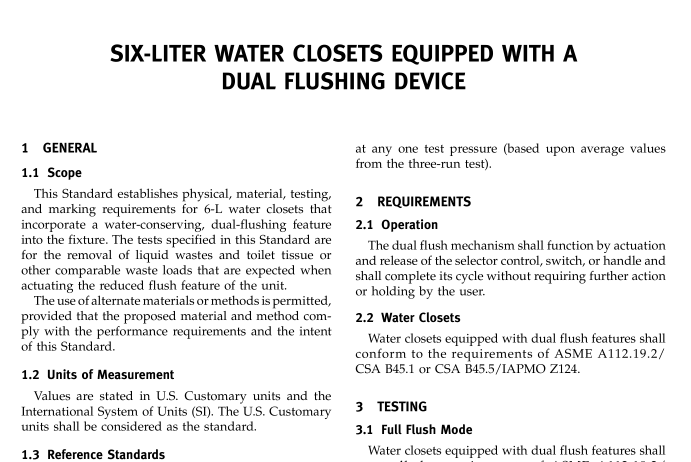ASME A112.19.14:2001 pdf download Six-Liter Water Closets Equipped With a Dual Flushing Device
1GENERAL1.1 Scope
This Standard establishes physical, material,testing,and marking requirements for 6-L water closets thatincorporate a water-conserving,dual-flushing featureinto the fixture. The tests specified in this Standard arefor the removal of liquid wastes and toilet tissue orother comparable waste loads that are expected whenactuating the reduced flush feature of the unit.
The use of alternate materials or methods is permitted,provided that the proposed material and method com-ply with the performance requirements and the intentof this Standard.
1.2 Units of Measurement
Values are stated in U.S.Customary units and theInternational System of Units (S).The U.S. Customaryunits shall be considered as the standard.
1.3 Reference Standards
The following documents form a part of this Standardto the extent specified herein (the latest issue shallapply):
ASME A112.19.2/CSA B45.1,Ceramic PlumbingFixtures
Publisher: The American Society of MechanicalEngineers (ASME),Two Park Avenue, New York,NY 10016-5990; Order Department: 22 Law Drive,P.O.Box 2900,Fairfield, NJ 07007-2900 (www.asme.org)CSA B45.5/IAPMO Z124,Plastic Plumbing FixturesPublisher: International Association of Plumbing andMechanical Officials (IAPMO), 5001 East PhiladelphiaStreet, Ontario, CA 91761 (www.iapmo.org)
1.4Definitions
dual flush: a feature that allows the user to flush thewater closet with either a reduced or full volume ofwater depending upon bowl contents.
low-consumption zoater closet: a water closet having anaverage water consumption (total flush volume) lessthan or equal to 1.6 gal (6 L) over the range of testpressures as specified in ASME A112.19.2/CSA B45.1for each water closet type, and not exceeding 2 gal(7.6L) at any one test pressure (based upon average valuesfrom the three-run test).
REQUIREMENTS2.1 operation
The dual flush mechanism shall function by actuationand release of the selector control, switch, or handle andshall complete its cycle without requiring further actionor holding by the user.
2.2 Water Closets
Water closets equipped with dual flush features shallconform to the requirements of ASME A112.19.2/CSA B45.1 or cSA B45.5/IAPMO Z124.
3TESTING
3.1 Full Flush Mode
Water closets equipped with dual flush features shallmeet all the requirements of ASME A112.19.2/CSA B45.1 for low consumption water closets when thefull flush volume is activated.
3.2 Reduced Flush Mode
3.2.1 Trap Seal Restoration Test.The water closetas tested in paras.3.2.2 through 3.2.4 shall also meet theperformance requirements of para.7.3 of ASMEA112.19.2/CSA B45.1.
3.2.2 Reduced Flush Volume Test.The reduced flushvolume shall not exceed 1.1 gal (4.1 L) per flush whentested in accordance with para.7.4 of ASME A112.19.2/CSA B45.1.This testing shall be conducted before thedurability testing in para.3.2.5.The same testing shallbe conducted after the durability testing in para.3.2.5and the reduced volume shall not vary more than 0.11 gal(0.41 L).
3.2.3 Dye Test
3.2.3.1 Test Method
(a)0.18 oz (5 g) of methylene blue powder shall beadded to 0.26 gal (1 L) of water and mixed thoroughlyin a clean container.
(b)The water closet under test shall be flushed onceand allowed to complete its filling cycle. One fluid ounce (30 mL) of the dye solution shall be added to the waterin the bowl and mixed thoroughly.
(c) 0.34 oz (10 mL) of this solution shall be removedfrom the bowl and shall be added to 5.75 oz (170 mL)of clean water in a suitable container (i.e.,dilution ratioof 17:1).A sample of this solution shall be set aside ina test tube or comparator vial as the control sample.(d) The water closet shall then be flushed severaltimes to ensure that all traces of the dye solution havebeen removed. One ounce (30 mL) of the dye solution[see para.3.2.3.1(a)] shall be added to the bowl. Theflushing device shall be actuated and released in a nor-mal manner and the test fixture shall be allowed tocomplete its filling cycle.A test tube or comparator vialshali be filled with water from the water closet bowland compared against the control sample.The test shallbe repeated two additional times and the results shallbe averaged.
NOTE: Use of a spectrophotometer shall be permitted in case ofdoubt; however, this method shall necessitate the use of a differentcolor dye.
3.2.3.2 Performance Requirement. A dilution ratioof at least 17:1 shall be obtained in each initial flush, forthe average of the three tests.
3.2.4 Toilet Paper Test
3.2.4.1 Test Media. The paper removal test in thereduced flush cycle shall be conducted as follows:(a) the test load shall be composed of four balls ofsix sheets of untreated single-ply toilet paper
b) each of the four balls in (a) shall be crumpled intoa loose ball measuring 2 in. to 3 in. (51 mm to 76 mm)in diameter.
The standard size test sheet shall be 4.5 in. ×4.5 in.(114 mm x 114 mm) or of equivalent surface area. Thesingle-ply toilet paper shall first meet both the absorp-tion and wet tensile strength requirements given inparas.3.2.4.1.1 and 3.2.4.1.2, respectively.
3.2.4.1.1 Absorption
(a)Test Method.A six-sheet strip of the proposed toiletpaper shall be obtained.The paper shall be wrappedsnugly around a piece of 2-in.(51-mm) Schedule 40 Pvcpipe. The paper shall be slid off the pipe. The tube ofpaper shali be grasped approximately halfway down itslength and shall be turned inside out and down overitself. This shall result in a ball approximately 2 in.(51 mm) in diameter. The ball (straight edges down)shall be dropped into a pan of water. The time it takesfor the ball to become fully saturated and sink belowthe water surface shall be recorded.
ASME A112.19.14:2001 pdf download
